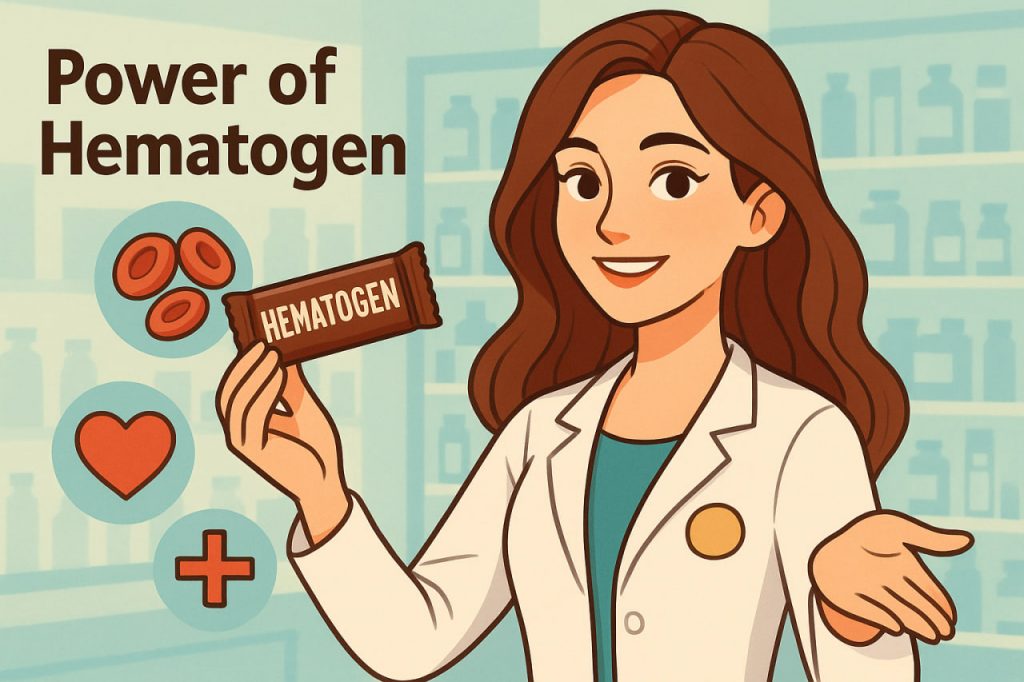Hematogen is a unique nutritional bar known for its sweet taste and its role in supporting blood health. Originally developed as a medical supplement, hematogen combines essential nutrients—particularly iron—with natural proteins and vitamins. For many generations, it has been considered a remedy for anemia and iron deficiency, especially among children and pregnant women. Although it tastes like candy, hematogen serves a serious purpose: to replenish iron in the body and promote the production of healthy red blood cells. This combination of nutrition and flavor has made it a popular and trusted supplement in many countries.
The Origin and History of Hematogen
The story of hematogen began in the late 19th and early 20th centuries, when doctors sought effective ways to combat iron deficiency. The first versions were made using defibrinated bovine blood, a rich natural source of hemoglobin, which contains iron. This innovation came from Russian and European medical laboratories that aimed to create an easily digestible, pleasant-tasting source of dietary iron. During the 20th century, hematogen bars became widely distributed through pharmacies and schools as part of public health programs. As nutrition expert Dr. Irina Volkova explains, “Hematogen was one of the earliest examples of functional food—medicine designed to nourish as well as heal.”
The Composition and Nutritional Value
The key ingredient in traditional hematogen is albumin, derived from processed animal blood. It is blended with condensed milk, sugar, vitamins, and natural flavors like cocoa or vanilla to create a sweet, chewy bar. This unique formula provides heme iron—the type of iron most efficiently absorbed by the human body. In addition to iron, hematogen contains amino acids, B vitamins, and protein, all of which help maintain healthy blood, support metabolism, and improve energy levels. Unlike synthetic iron tablets, hematogen offers a balanced and easily digestible source of nutrition that appeals even to children.
The Health Benefits of Hematogen
Hematogen is most often used to prevent and treat iron-deficiency anemia, a condition in which the body lacks enough healthy red blood cells to carry oxygen. Regular consumption helps restore iron balance, improving oxygen flow, reducing fatigue, and enhancing concentration. It is particularly beneficial for women, children, and people recovering from illness or blood loss. However, hematogen should not be eaten in excess—it is still a nutritional supplement, not candy. Dietitian Dr. Markus Klein notes, “Hematogen works best when used moderately as part of a balanced diet. It replenishes iron stores safely while providing quick energy.”
Modern Variations and Uses
Today’s hematogen comes in many varieties—classic bars, chocolate-coated versions, and even vitamin-enriched forms. Some versions replace animal-derived albumin with plant-based iron sources, appealing to vegetarians. Modern manufacturers also fortify the product with extra nutrients like vitamin C and folic acid, which help the body absorb iron more effectively. Despite these innovations, the fundamental goal remains the same: to combine taste with therapeutic value. Hematogen continues to be sold in pharmacies and health stores, maintaining its reputation as both a nostalgic treat and a scientifically grounded supplement.
Safety and Recommendations
While hematogen is generally safe for most people, excessive consumption can lead to iron overload, which may cause digestive discomfort or other complications. It is best used under the guidance of a healthcare provider, especially for individuals already taking iron supplements. Those with diabetes should be cautious due to its sugar content. As with all nutritional products, balance is key. Hematogen is not a substitute for a healthy diet rich in iron-containing foods like meat, legumes, and leafy greens. Instead, it serves as a convenient way to support iron intake when dietary sources are insufficient.
Interesting Facts
- The name “hematogen” comes from Greek roots meaning “producing blood.”
- It was once prescribed to soldiers and factory workers to fight fatigue and blood loss.
- Early versions were sold exclusively in pharmacies as a medicinal product.
- Modern hematogen bars often contain around 2–4 mg of iron per serving.
- Its distinctive dark color comes from the hemoglobin-rich base ingredient.
Glossary
- Hemoglobin — The iron-containing protein in red blood cells responsible for carrying oxygen.
- Albumin — A protein derived from blood plasma used as a nutrient source in hematogen.
- Heme iron — The type of iron found in animal sources, easily absorbed by the body.
- Anemia — A condition characterized by a deficiency of red blood cells or hemoglobin.
- Functional food — A food product designed to provide health benefits beyond basic nutrition.


